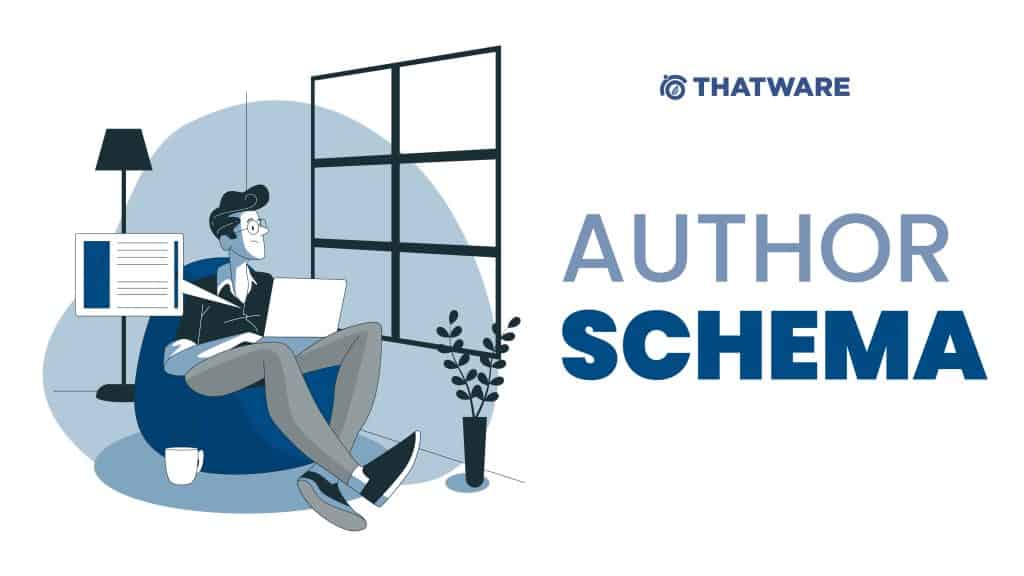Have you ever considered how many articles and blog posts are produced on the internet in a single day?
That implies there’s a lot of information available on the internet.
As a result, we’ll go through the Author Schema markup and what it means for both your content and your SEO.

Why Include Author Schema?
Schema (also known as structured data, rich snippets, or microdata) is a globally understood language by search engines.
It enables search engines to comprehend your web pages better, allowing them to identify the most relevant information for consumers’ specific searches. Schema essentially tells search engines what your site or a single page is about in very basic terms.
Recognizing that there is a wealth of potential material available for consumers to discover, Google introduced Article structured data for news, blog, and sports article pages, allowing your content to be better recognized and displayed more prominently in Google search results.
Aside from the prospect of your material being provided as a rich result, structured data allows your content to be offered as a voice response to people who ask questions to a Google Assistant.
This is a once-in-a-lifetime chance that you should not pass up. According to a Google and Peerless Insights survey, 72 per cent of individuals claim they use their voice-activated gadget regularly.
What Pages Can I Use Author Schema On?
AMP
Accelerated mobile pages have been a hot issue for blog and publishing sites. Because they are intended for mobile users, they are lightweight sites that provide a quick and interesting experience.
The combination of AMP pages with Article structured data allows your material to show in Google SERP features like the top stories carousel, visual stories, rich results host carousel, and other rich results in mobile search results.
You can show these results in various ways, including photos, page logos, and a range of other interesting search result elements.
Non-AMP Pages
Non-AMP pages can also contain the Article structured data to assist Google to understand more about the content of the webpage. Furthermore, it enables Google to display better headline copy, graphics, and the article’s publication date.
What Kinds of Author Schemas Can I Include?
Schema.org provides several distinct Author Schemas:
- AdvertiserContentArticle
- news article
- Report
- SatiricalArticle
- ScholaryArticle
- SocialMediaPosting
- TechArticle
How To Insert An Author Schema
As you can see, Author Schema may significantly influence SERP listings and user experience. Fortunately, there are several methods for including the Author Schema.
Schema Builder (Schema.Dev)
Schema Builder is a free Google Chrome plug-in extension that helps you quickly create structured data for your website.
The easy point-and-click user interface lets you build up your schema by following the provided directions – no structured data knowledge is necessary.
It supports over 40 schema types, including, of course, the Author Schema. You may copy and paste JSON-LD code right into your websites.
CMS Plug-ins (Yoast)
Structured data implemented using built-in plug-ins such as Yoast SEO in content management systems like WordPress.
Yoast SEO makes use of schema.org data, which is a community-driven initiative to distribute schema types. The plug-in also includes a structured data graph showing search engines how various components of structured data on your site work together.
Structured Data Markup Helper Tool (Google)
Google provides several tools for creating and deploying structured data. After all, the markup does assist them in learning more about the web’s contents.
Structured Data Markup Helper is one possibility.
Choose the data type you wish to produce (12 possibilities) and input the page’s URL or HTML. When you click the relevant region of a page, the Markup Helper fills in the information. The JSON-LD markup can then be seen.
Article Structured Data Property Requirements
Depending on the kind of page, there are property requirements for the Article structured data (i.e. AMP versus non-AMP). Let’s take a look at each one separately.
AMP
For the content of AMP pages to be suitable for rich results on the SERP, the pages must have the appropriate attributes.
To improve the user experience, you may also include the suggested attributes, which provide extra information about the content of your pages.
The following is a list of these AMP page characteristics.
Non-AMP Pages
It is critical to include the suggested attributes for non-AMP sites for Google to comprehend your pages better.
What adjustments are regarded as recommended versus needed based on AMP versus non-AMP? A list of suggested characteristics for non-AMP pages is provided below.
Recommended Characteristics:
- dateModified
- datePublished
- headline
- image
Author Schema Guidelines
To make your structured data acceptable for inclusion in Google’s search results, you must meet several requirements, including webmaster guidelines, general structured data rules, and technical guidelines.
Further rules exist for AMP logos and AMP storey metadata in specific circumstances, which are explored more below.
Note: Please keep in mind that if one or more of these standards are broken, Google takes manual action against your site.
Webmaster Policies
There are specific standards to follow that will assist Google in finding, indexing, and ranking your site and its content. The webmaster guidelines are divided into two sections: General Requirements, which help Google locate, understand, and use your page, and Quality Guidelines, which encompass basic concepts and particular guidelines such as not fooling users.
A breach of Google’s webmaster standards may result in the removal of your web pages from the search results.
Guidelines For General Structured Data
All structured data is subject to general standards. You must fulfil these standards for structured data to be shown as rich results on Google SERPs.
The generic structured data guidelines are divided into two sections: technical guidelines and content guidelines.
Is Googlebot able to access your structured data? Examine your robots.txt, noindex tags, and other settings. Specifics such as format (JSON-LD is suggested) and access are covered in technical recommendations.
(Google does provide a Structured Data Testing Tool to help you determine whether your code is eligible for rich results.)
Content rules encompass content, relevance, completeness, location, specificity, pictures, and many things on a single page.
Technical Instructions
Although technical guidelines are mentioned in the general guidelines, a separate section on the Author Schema developer’s website is dedicated to technical recommendations.
This section focuses on two crucial points:
- Consider adding structured data for subscription and payout material if your site is subscription-based or requires users to register to access the content.
- If your material is divided into sections, point your rel=canonical tag to a “view-all” page or each page.
AMP-Specific Recommendations
As previously noted, there are times when particular requirements exist specifically for AMP content.
Guidelines for the AMP Logo
The following criteria apply to all AMP pages (including AMP stories) that incorporate logos:
- Google Images must support the file format.
- Avoid using animation.
- The logo’s graphic area should be readable against the selected background colour.
The following criteria apply to ordinary AMP pages (not AMP stories) that include logos:
- The logo must be a rectangle, not a square.
- The logo should fit within a 60600 px rectangle (it is preferred that the logo be exactly 60 px high).
Metadata Guidelines For AMP Stories
According to amp.dev, metadata characteristics are in charge of displaying the tale preview across the “Web Stories ecosystem.” It’s crucial to emphasize, however, that metadata attributes are a complement to structured data.
The following characteristics listed to Amp.dev, along with whether they are needed or optional:
- self-contained (required)
- the title (required)
- a publisher (required)
- publisher-logo-src (required)
- poster-portrait-src (required)
- poster-square-src (optional)
- poster-landscape-src (optional)
- the entity (optional)
- entity-url (optional)
- entity-logo-src (optional)
- landscape-supports (optional)
- background music (optional)
- A real-life storey (optional)
- live-story-incapable (optional)
- interval-between-data-polls (optional)
The Author Schema markup is a simple approach to make your SERP listing stand out with rich results, perhaps attracting a greater click-through rate from searchers.
Furthermore, its capacity to make your content compatible with voice-activated devices has a chance not to be passed up.
Although there are criteria to follow to guarantee that your Author Schema is acceptable for inclusion in Google’s results, several tools are available to help you produce the necessary structured data.


